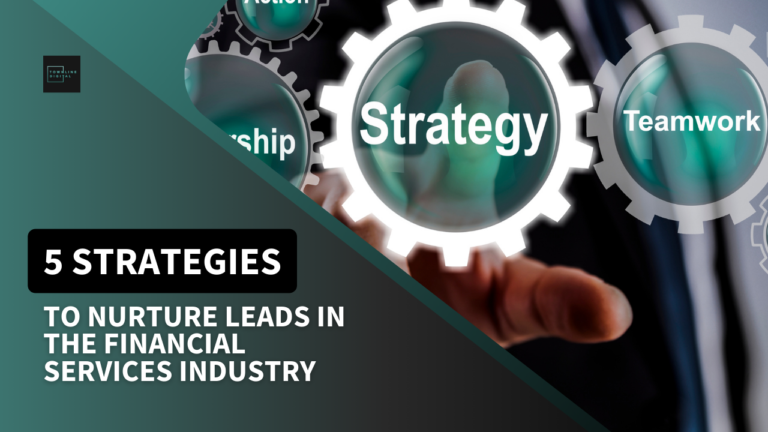
Read More Blogs

Strategies for Effective Lead Nurturing in Financial Services
Date Published: October 27, 2023
In the financial services industry, acquiring new leads is just the first step in building a successful business. Converting those leads into customers requires implementing effective strategies for lead nurturing. Lead nurturing is the process of building relationships with potential customers through follow-up communication and providing relevant information that educates and informs them.
In today’s digital age, lead nurturing is even more critical, with research indicating that about 80% of potential customers require at least five interactions before making a purchase.
This article will explore five strategies for effective lead nurturing in financial services, including creating valuable content, personalizing communication, automating the process, understanding the customer journey, and tracking and analyzing results.
1. Create Valuable Content
Creating valuable content is critical in attracting and nurturing leads within the financial services industry. With so much information readily available online, potential customers are looking for informative and educational content that helps them make informed decisions. According to research, content marketing generates three times more leads than traditional marketing, making it a powerful tool for lead nurturing.
To create valuable content, financial services professionals should:
Understand their audience
To create relevant and useful content, professionals first need to understand their target audience. This involves identifying their needs, challenges, and pain points. To achieve this, professionals can use surveys, social media monitoring, and analyzing customer interactions to gain insights.
Provide educational content
Financial services professionals should provide useful and educational content that addresses the needs of their audience. This can include topics such as financial planning, investment strategies, and money management. Educational content positions professionals as trusted advisors and builds trust with potential customers.
Utilize various content formats
To appeal to a broad audience, financial services professionals can utilize different content formats such as blog posts, social media posts, videos, podcasts, and infographics.
2. Personalize Communication
Personalizing communication is crucial in building relationships with leads and converting them into customers. Personalization involves customizing communications based on the lead’s behavior, preferences, and interests. Personalization can be achieved through various means, including:
Customized Emails
Personalizing emails is an effective strategy for lead nurturing. Emails that address the lead by name, provide relevant and timely information, and offer personalized offers or promotions are more likely to convert into customers.
Personalized Landing Pages
Customizing landing pages based on the lead’s behavior, preferences, and interests helps to improve the user’s experience and increase conversions.
3. Automate the Process
Automation is a vital part of lead nurturing in financial services. Automating the process helps to streamline communication with leads and enables financial professionals to focus on building relationships with customers.
Specifically, automation can assist in:
Lead Scoring
Automated lead scoring involves assigning a score to leads based on their behavior, demographics, and interests. This helps financial professionals prioritize leads and ensures they focus their efforts on the most promising leads.
Lead Segmentation
Segmenting leads based on their interests, behavior, and demographics enables financial professionals to provide targeted communication and relevant information to nurture the lead.
Automated Emails
Automated email campaigns allow financial professionals to follow-up with leads at predetermined intervals, provide relevant information, and offer personalized promotions.
4. Understand the Customer Journey
Understanding the customer journey is essential in developing effective strategies for lead nurturing in financial services. The customer journey involves various stages that a lead goes through before converting into a customer. These stages include:
Awareness Stage
At this stage, the lead becomes aware of a particular need or problem they have and begins to search for solutions.
Consideration Stage
At this stage, the lead starts to research and consider various options and solutions to their problem.
Decision Stage
At this stage, the lead decides on a solution and starts to look for providers that can best meet their needs.
Understanding the customer journey enables financial professionals to provide targeted communication and content that speaks to the particular stage of the lead.
5. Track and Analyze Results
Tracking and analyzing the results of lead nurturing campaigns are critical in optimizing future strategies. By monitoring metrics such as engagement rates, conversion rates, and open rates, financial professionals can identify areas of success and areas where improvement is needed.
Tracking and analyzing results can assist in:
Identifying Ineffective Tactics
By analyzing results, financial professionals can identify tactics that are not effective and eliminate or modify them to improve results.
Optimizing Tactics
Analyzing results can also identify areas where tactics can be optimized for better results.
Conclusion
Effective lead nurturing is critical in converting leads into loyal and repeat customers in the financial services industry. Strategies for effective lead nurturing include creating valuable content, personalizing communication, automating the process, understanding the customer journey, and tracking and analyzing results. By implementing these strategies, financial professionals can build meaningful relationships with leads and increase conversion rates, leading to business success.

Privacy Policy
©2023 Townline Digital

